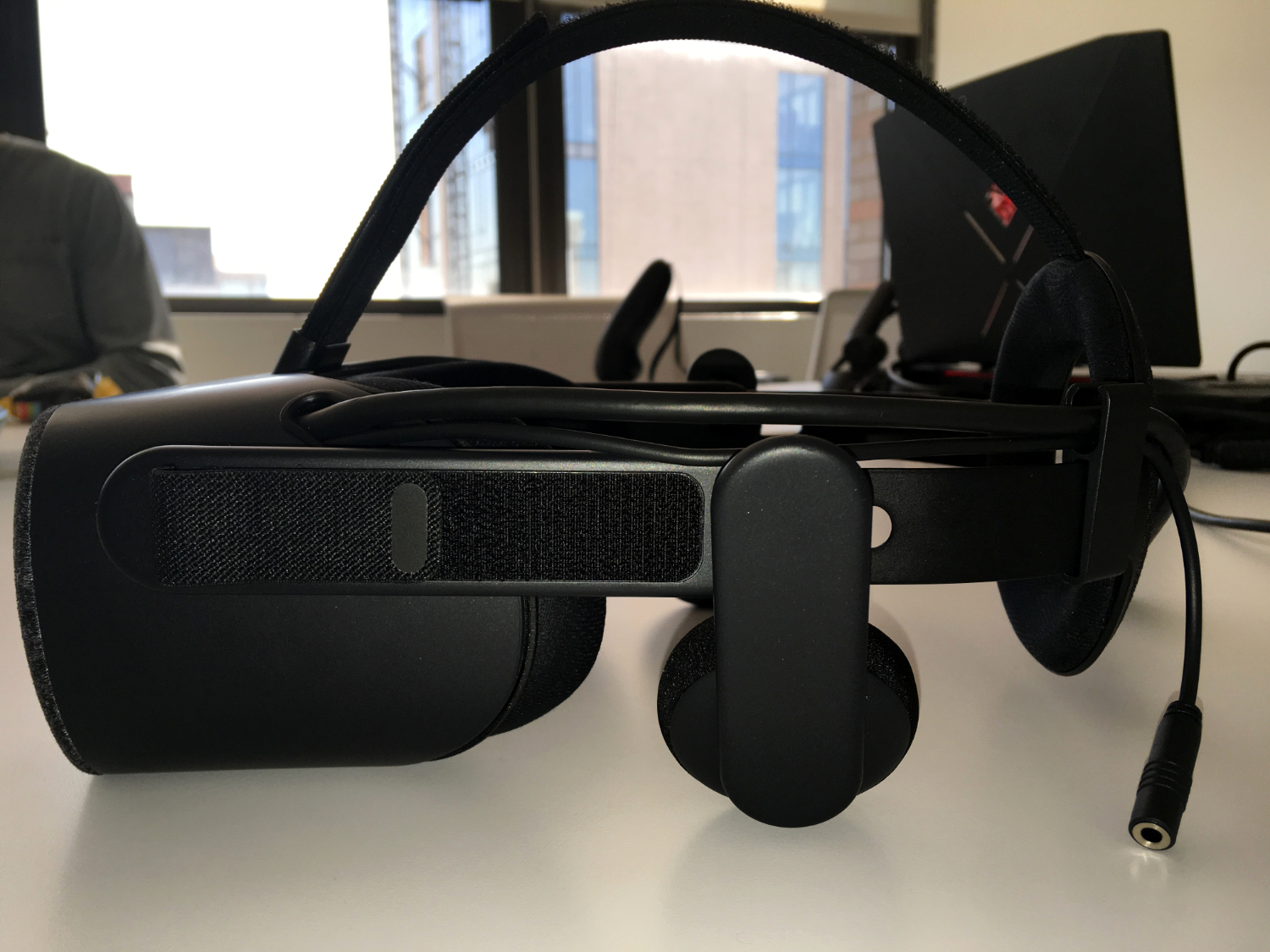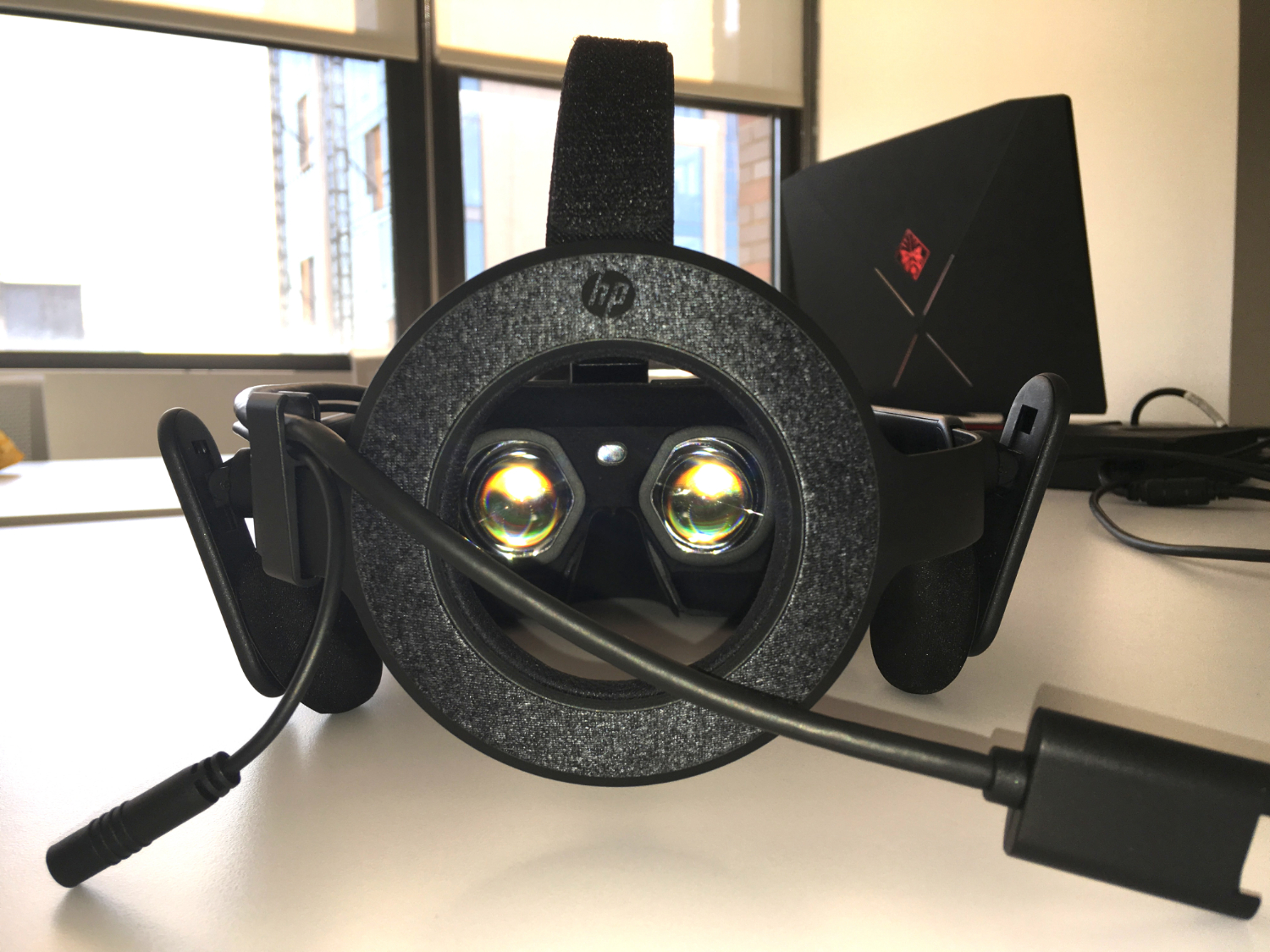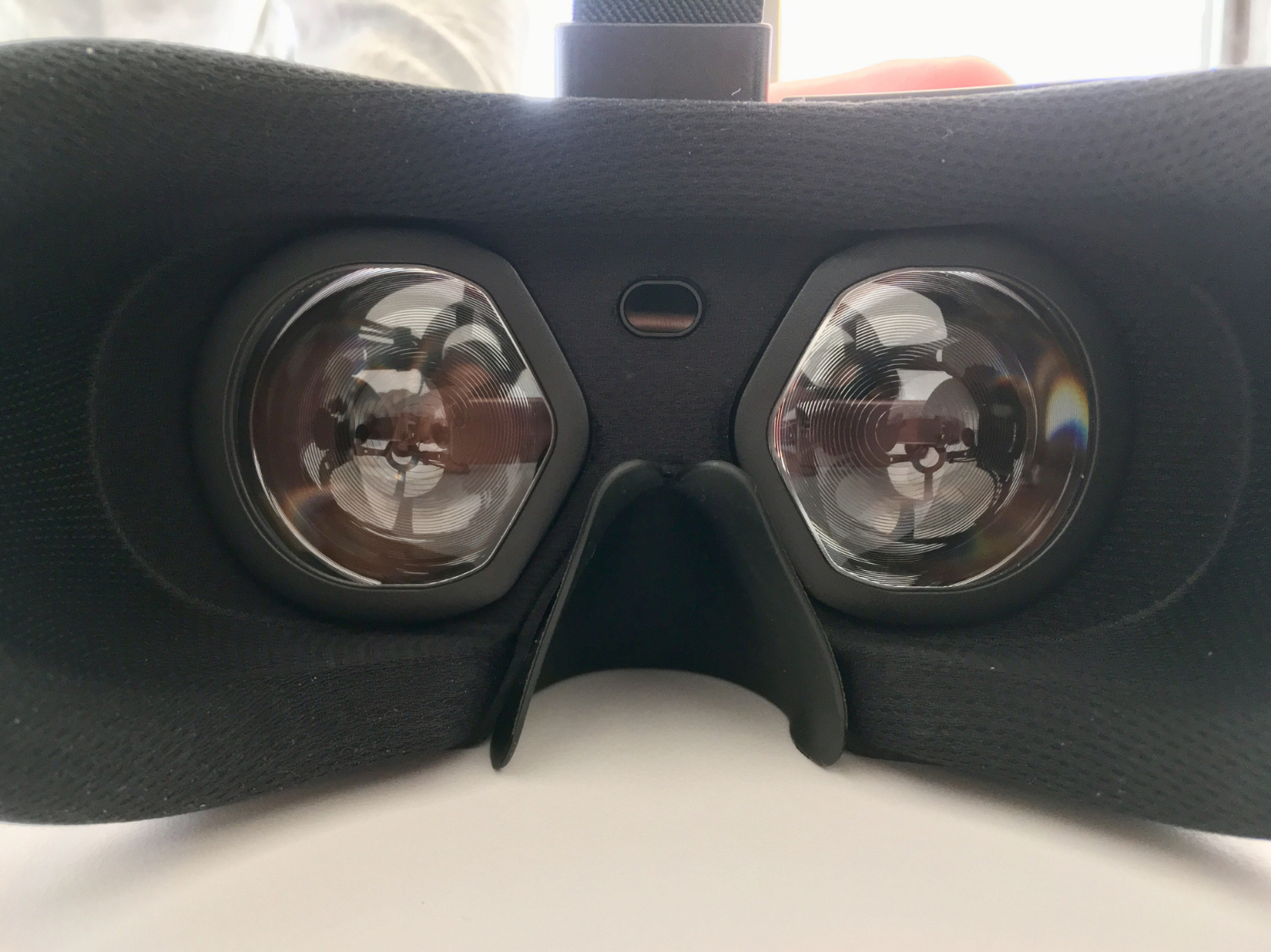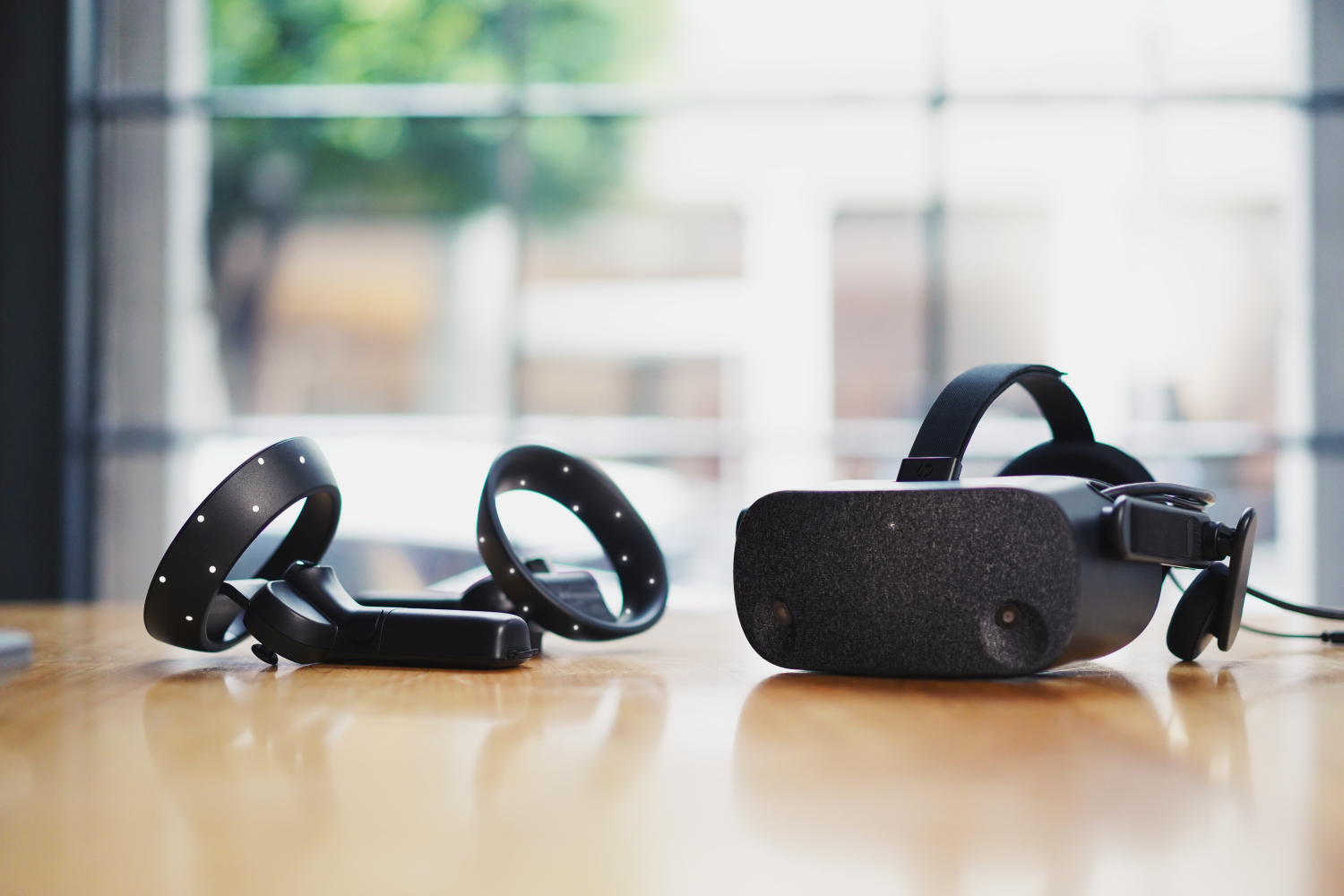HP Reverb Hands-On: HTC Vive Pro’s Got Competition
HP is looking to poach HTC Vive Pro fans with its new Reverb VR headset debuting in late April. Its resolution—twice that of the Vive Pro—plus a lightweight, comfortable fit and impressive $599 price tag should be enough to make the incumbent premium VR headset sweat--especially since it didn't make my face do so.
In my meeting with HP about today’s announcement, the company made it very clear that it’s positioning its second Windows Mixed Reality (MR) headset as a Vive Pro rival. But HP’s head-mounted display (HMD) boasts greater per-eye resolution (2160x2160 vs. 1440x1600) and a wider field of view (114 degrees vs. 100 degrees).
Upon strapping on the Reverb, I could immediately feel the difference between it and the Vive Pro. The Reverb didn’t weigh down on the top of my head, and that’s because it's half the Vive Pro’s weight.
HP also redesigned the Reverb’s head strap compared to the HP Windows MR Headset, HP’s first VR headset. Instead of using a halo band design, which included plastic and cushioning pads in the front of the back of the head, the Reverb uses a sawstrap design similar to the Oculus Go. It has a lightweight strap going across the top of the head to the back, where there’s a plastic circle and a dial for tightening the HMD.
The consumer version of the headset will come with a machine-washable (hang or tumble dry low) cloth face mask, while business users will get a TP or PU leather one that is cleanable with sanitizer wipes. I used the cloth facemask, which was soft, squishy, yet light, and didn’t leave my face with a frame of light perspiration around the eyes like most VR headsets do after a while.
But does the Reverb really have what takes to outshine the Vive Pro and other competitors, like the Samsung HMD Odyssey +, which has the same resolution and refresh rate as the Vive Pro? I tried some demos and games in the Reverb to get an idea of its potential. But first, here’s a quick comparison of the Reverb and Vive Pro’s specs.
HP Reverb vs. HTC Vive Pro Specs
| Row 0 - Cell 0 | HP Reverb | HTC Vive Pro |
| Display | 2x 2.89-inch LCD with Pulse Backlight technology | 2x 3.5-inch AMOLED |
| Per Eye Resolution | 2160x2160 | 1440x1600 |
| Refresh Rate | 90Hz | 90Hz |
| FOV | 114 degrees | 110 degrees |
| Lens Adjustment | 63mm +/-8mm via software | 60-72mm mechanical IPD adjustment |
| Sensors | Accelerometer, magnetometer, gyroscope | Accelerometer, magnetometer, gyro sensor, proximity sensor |
| Tracking Technology | Windows Mixed Reality inside-out 6-DoF motion tracking | Valve SteamVR Tracking 2.0 |
| Integrated Camera | 2x front-facing | Stereo cameras: Chaperone, Passthrough |
| Audio | Removable integrated headphonesIntegrated mic3.5mm headphone/mic jack | Integrated headphonesIntegrated mic |
| HMD ports | DisplayPort 1.3USB 3.0 | HDMIUSB 3.0 |
| Dimensions (WxHxD) | 6.97 x 2.17 x 3.31 inches177 x 55 x 84mm | 7.48 x 4.72 x 5.31 inches190 x 120 x ~135 mm |
| Weight | 1.1 pounds / 498.95g | 2.2 pounds / 1,017g |
| Price | $599 (consumer version) | $799 |
Indeed, the star of the Reverb’s spec sheet is its resolution. For business users it’s not the highest resolution available today. Pricey headsets like the $899 Pimax 8K and $6,000 XTAL beat it. But it does pack more pixels than the Vive Pro and Pimax 5K Plus ($699).
Get Tom's Hardware's best news and in-depth reviews, straight to your inbox.
In addition, the Reverb’s 90Hz refresh rate is on par with the Vive Pro and Oculus Rift. To reach the 90Hz refresh rate, the graphics card must support DisplayPort 1.3. It’s recommended the Reverb connect to a PC with a GTX 1080 graphics card or better.
But it’s not just about the specs. HP also made design decisions aimed at increasing sharpness for enhanced ability to see things like textures and text.
For one, the Reverb has LCD panels, instead of OLED like the Vive Pro or Rift. John Ludwig, global lead VR headsets at HP Inc., told Tom’s Hardware this is because LCD has an RGB subpixel stripe, meaning each pixel gets a red, green and blue subpixel. This differs from the OLED competitors, which use a PenTile layout, where there are only two subpixels. And, Lugwig said, each pixel can’t make every color. LCD also allows for a more pixel-dense display, which lends to smaller headgear overall, he added.
Additionally, HP adjusted the sweet spot of the displays. Ludwig admitted that in the first HP HMD, the sweet spot was a little small and got fuzzy near the edges. Your pupils had to align vertically with the lenses to get the best image. The goal with Reverb, Ludwig said, is to increase clarity, so you can see the resolution, while enlarging the sweet spot. The headset achieves some of this with its head strap, which is supposed to help center the eyes in the sweet spot better for longer use.
Further, the Reverb ditches the symmetrical circular lenses of its predecessor for asymmetrical lenses that are square-shaped with rounded edges, instead of circles, which Ludwig claims also enhances the FOV.
Ludwig noticed that with Fresnel lenses, HP found an inverse relationship between FOV and the lens clarity.
“We went to asymmetric because it allowed us to lower the per eye FOV, which boosts the clarity a bunch and increases the sweet spot about 33 percent. Then we combined both eyes.” Ludwig explained. “Our binocular FOV for both eyes has gone up from 110 to 114 degrees, but we managed to boost the clarity because we lowered the FOV per eye.”
HP Reverb in Action
I wore the Reverb for about 20 minutes and, as mentioned, it was surprisingly comfy. Most VR headsets push down on my nose and/or leave the area around my eyes hot and a touch moist. But my face still felt clean after wearing the Reverb, and the fabric face cushion didn’t stick to my face as I took it off. However, I wasn’t wearing glassing when I tried the Reverb, and the headset’s interpupillary distance (IPD) adjustment is through software only.
So, what’s VR look like with 9.3 million pixels? Since HP designed the headset primarily with businesses in mind, I tried out an architecture interior design demo, where I examined different desk textures very closely and was able to see the gradient color and grain in the wood in detail.
In another demo, I played a nurse handing off different medical tools while watching a real-life video of a graphic surgery playing overhead. Again I was met with strong detail as I watched bright red blood ooze out tearing in the skin. It looked only slightly less realistic than if I were watching it on a PC monitor.
Text is also easy to read on the Reverb. In a safety training demo I identified safety hazards and selected their description and subsequent plan of action from a list of choices. The characters on a white background never seemed jittery or blurry. I could see myself reading an entire article on the headset without struggling.
I also tried some games, like The Labs, where the game’s warehouse filled enough of my peripheral where I wasn’t distracted. This is a welcome upgrade from HP’s previous HMD, which had a 100-degree FOV that felt restricted and even induced a sense of tunnel vision in our review.
Since I was trying out a second-level production headset, it had a few kinks to work out. For one, I noticed a faint gray screen door effect, like a subtle gray fog, that was particularly prominent on white backgrounds. Ludwig said this is because of the structure of the LCD panel and that it won’t be visible when the headset sees general availability.
And during the design demo, in my right peripheral I saw a blue, red and yellow line running along the gap between some tiles. Ludwig said is because they didn’t cut out enough of the eye cup in the pre-production model. The eye cup is a cone that goes from the lenses to the display. My sample headset had a light from the display bouncing off the interior of the eye cup, which was visible on the edges of the cup. That too will be fixed fix before the Reverb’s release, Ludwig claimed.
Same Ol’ Motion Controllers
The Reverb uses the same motion controllers as the previous HP headset. However, this version of the controllers also connect via Bluetooth to the headset instead of the PC only. They’ll come pre-synced to the HMD.
Ludwig said HP is maintaining the status quo here because the controllers are already “robust,” and their joystick and trackpad offer compatibility with many Windows MR and SteamVR apps.
The consumer version of the HP Reverb will cost $599 and come with two motion controllers, a 3.5-meter cable for connecting to PCs, a DisplayPort to Mini DisplayPort adapter and a washable fabric face cushion.
The enterprise version will cost $649 and adds a 0.6-meter headset cable for connecting to the HP Z VR backpack.
Stay tuned for our review of the Reverb, where we’ll see how well HP’s high-resolution headset can handle VR games.
Scharon Harding has over a decade of experience reporting on technology with a special affinity for gaming peripherals (especially monitors), laptops, and virtual reality. Previously, she covered business technology, including hardware, software, cyber security, cloud, and other IT happenings, at Channelnomics, with bylines at CRN UK.





